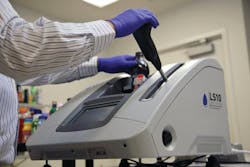Screening technology poised to ease liquid restrictions at airports
If you have passed through any airport recently, you’ve probably seen someone standing in the security line chugging a bottle of water or soda to finish it off before they make it to the checkpoint. This inconvenience could soon be coming to an end for travelers in some parts of the world as a new liquid bottle screening technology begins to gain traction in the industry.
Heathrow Airport Limited recently purchased the LS10 liquid bottle scanner, which is manufactured by Battelle and distributed by Sellex International, for use in its terminals at London Heathrow Airport, as well as several other airports in the UK including Aberdeen, Southampton and Glasgow International. The move follows the European Union’s decision to ease restrictions on airport liquid bans. Beginning in January, the EU will permit a limited category of liquids aerosols and gels onto planes under a phased implementation process.
Mark Davis, director of business development for Battelle, said they were initially approached by their partner Sellex about five years ago after receiving a grant from the Transportation Security Laboratory to develop a liquid bottle scanning solution. “With that idea, Battelle went about designing and developing an instrument that employed dual-detection technology to discriminate benign (liquid) threats from a wide variety of liquid container types,” Davis said.
Based in Columbus, Ohio, Battelle is a non-profit charitable trust research and development organization that does contract research for commercial companies, as well as government agencies. The organization also develops its own products.
According to Wesley Pirkle, senior research scientist for Battelle, the LS10 uses both radio frequency and ultrasonic technology to detect whether or not a liquid could be dangerous.
“We first interrogate the container using a very low power radio frequency pulse and we look at the signal that gets reflected or sent back to us from the liquid. Then we send a sound wave through the liquid and we look at how the sound wave interacts with the liquids,” Pirkle explained. “The types of liquids that we are able to identify are many flammable liquids, liquid explosives, so this would be anything you could mix together and send through a security line that you could later set off. Also precursors, if people try to take one constituent through one line and then another person has the rest of it in another line, we can also detect those individual parts.”
The ban on carrying liquids through checkpoints or carry-on luggage began in 2006 after a plot to detonate liquid explosives onboard planes traveling to the U.S. and Canada was thwarted by British authorities. Shortly thereafter, the U.S. Transportation Security Administration adopted what is known as its “3-1-1 Rule” for liquids. The rule requires that liquids in carry-on luggage must be in containers of 3.4 ounces or less and also packed in a single, clear one-quart bag. Each passenger is restricted to a single bag for their carry-on liquids. That ban was also widely adopted in the EU.
“There have been ongoing attempts to solve the technical problem of how can you scan all of these liquids and separate out what’s ok to go through and what’s not,” said Pirkle. “In Europe, they have tried on several occasions to lift their ban and they have always ended up pushing the deadline because they felt that the development of the systems wasn’t there yet, that there would be too many false alarms and the public wouldn’t tolerate the bureaucracy of getting through the security line. But I would say in the last two or three years, several systems have come into existence including ours that, in our opinion, significantly address these shortcomings. The false alarm rates are much lower. The scan time for those systems is much lower.”
For example, Pirkle said the LS10 can measure all bottle types including metal, plastic, glass and even cardboard juice boxes, which couldn’t be done previously in an effective manner. “But now that’s changed. We have systems like ours that we can scan all of those container types using our dual technology and the false alarm rates are very low and the scan times are also very low – in the two to five seconds range,” Pirkle added.
Davis said that the LS10, which weighs less than 40 pounds, is also very versatile and portable. “It’s very important to have low false alarm rates, but compared to other equipment in the marketplace today, ours can handle a plethora of container types, shapes and sizes,” Davis said.
In addition to the aforementioned airports in the UK, Davis said that the company’s solution has also been selected for use in two Australian airports (Brisbane and Sydney), as well as several Scandinavian countries. The company’s technology is also being evaluated for use domestically in the U.S.



